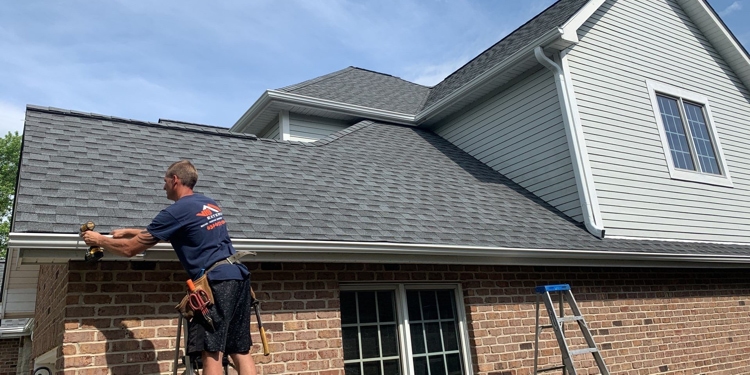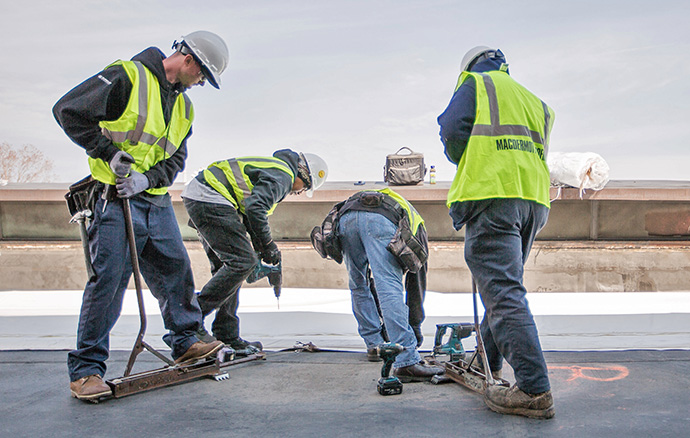Professional Cuyahoga Falls Roof Repairs for Residential and Commercial Properties
Professional Cuyahoga Falls Roof Repairs for Residential and Commercial Properties
Blog Article
A Comprehensive Overview to Effective Roof Flat Roofing Installment
The ins and outs of flat roof setup demand a precise technique, beginning with an extensive understanding of various flat roofing types and the necessary materials required for ideal efficiency. A successful installment hinges not just on the selection of products but additionally on the preparation and implementation of each action involved in the procedure.
Understanding Apartment Roofing System Kind
When taking into consideration level roofing systems, it is crucial to comprehend the various kinds available, as each deals distinctive advantages and drawbacks tailored to certain demands. The most common kinds of flat roofing systems include Built-Up Roof covering (BUR), Modified Bitumen, and Single-Ply membrane layers.
Built-Up Roof covering contains numerous layers of asphalt and gravel, giving exceptional durability and climate resistance. It is especially helpful in locations prone to severe weather but might need more upkeep because of its intricate building.
Customized Bitumen is a preferred option for its simplicity of setup and versatility. It frequently uses a torch-applied or self-adhesive technique, which can be helpful for quick fixings and long-term performance. Its life expectancy can be much shorter contrasted to BUR.
Single-Ply membranes, including Thermoplastic Olefin (TPO) and Ethylene Propylene Diene Monomer (EPDM), are identified for their lightweight nature and energy effectiveness. These products are typically favored for industrial structures due to their cost-effectiveness and ease of installation (Cleveland Roofing Specialists). However, they may not provide the same degree of insulation as other choices.
Each roofing type needs cautious consideration based on environment, budget, and particular job needs.
Necessary Materials for Apartment Roof Covering
A range of crucial materials are important for the successful installment of flat roof systems. The option of materials straight effects toughness, efficiency, and overall efficiency.
One of the main materials is the roof covering membrane layer, which can be built from different materials such as polycarbonate polyolefin (TPO), ethylene propylene diene monomer (EPDM), or PVC. Each kind offers distinct benefits, consisting of UV resistance and adaptability, which are crucial for prolonged performance.
In enhancement to the membrane, insulation materials play a considerable role in power effectiveness. Rigid foam boards or polyisocyanurate insulation are popular choices, as they give superb thermal resistance and wetness monitoring.
Additionally, roofing adhesives and sealants are necessary for making certain a leak-proof installment. These items have to be suitable with the picked membrane to stop damage gradually.
Getting Ready For Setup
Proper prep work is important for a successful flat roofing system installment, as it lays the groundwork for a efficient and long lasting roofing system. Begin by performing an extensive evaluation of the existing roofing structure.
Next, collect all necessary tools and materials, making sure that they satisfy sector requirements. This includes water resistant membranes, insulation, flashing, and fasteners. Familiarize on your own with the maker's specifications, as adherence to these guidelines is vital for guarantee purposes.
Consider weather condition conditions; prevent installation during hefty rainfall or extreme temperature levels, which can influence product efficiency. By taking these preparatory actions, you can boost the likelihood of a successful flat roofing system setup that fulfills both architectural and visual requirements.
Step-by-Step Installation Refine
With the foundation established via comprehensive prep work, the next stage includes executing the flat roof installment methodically. This action is critical for preserving the roof's integrity over time.
Following the vapor obstacle installment, set insulation boards, ensuring they fit securely with each other to minimize thermal bridging. Safeguard the insulation with suitable bolts based upon the roofing system kind and neighborhood structure codes. As soon as the insulation remains in place, it's time to use the roofing membrane layer. Depending upon the picked material-- such as TPO, EPDM, or customized bitumen-- set up the membrane according to the manufacturer's requirements.
Guarantee correct overlap at sides and seams to produce a water tight seal. Make use of adhesives, mechanical bolts, or heat welding as needed. Set up flashing around borders, vents, and any roofing infiltrations to boost waterproofing. After installation, carry out a detailed inspection to identify any kind of prospective concerns prior to ending the try this site task, ensuring a trustworthy and robust level roof covering system.
Maintenance Tips for Long Life
Regular maintenance is necessary to make sure the long life and performance of a level roofing system. One of the key tasks is to conduct routine evaluations at least two times a year, preferably in springtime and autumn. During these examinations, seek signs of wear, such as blisters, splits, or pooling water, click to find out more which can suggest underlying issues.

Guaranteeing correct drain is essential to prevent water buildup. Inspect and clear rain gutters, downspouts, and scuppers to assure unobstructed water circulation. Furthermore, evaluate seals around vents, skylights, and other penetrations for any type of indications of deterioration, applying caulk or sealer as required to maintain a water tight obstacle.
Last but not least, consider specialist maintenance services every couple of years for comprehensive assessments and fixings. By sticking to these maintenance tips, you can significantly expand the life of your level roof covering, ensuring it continues to be a reliable guard versus the aspects.
Conclusion
Efficient level roof covering installment necessitates an organized strategy encompassing extensive inspections, product option, and thorough prep work. Sticking to the described steps throughout the setup procedure makes certain the appropriate application of roof covering membranes and insulation while boosting waterproofing through efficient blinking installation. Moreover, implementing routine maintenance methods considerably adds to the longevity of the roof system. By complying with these guidelines, a trustworthy and durable level roof option can be achieved, efficient in enduring numerous environmental problems.
The complexities of flat roof installment need a precise approach, beginning with an extensive understanding of various flat roofing system types and the essential materials needed for optimal performance.Correct preparation is necessary for an effective level roofing system installation, as it lays the groundwork for a long lasting and efficient roof system. After setup, perform a thorough evaluation to determine any type of prospective concerns before concluding the job, ensuring a robust and reliable flat roof system.

Report this page